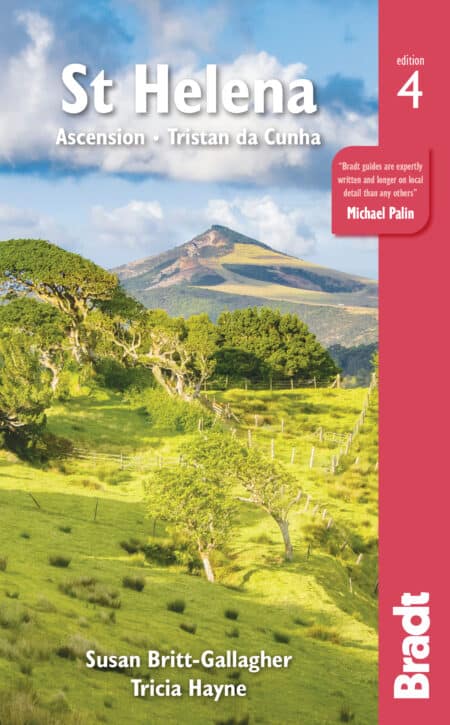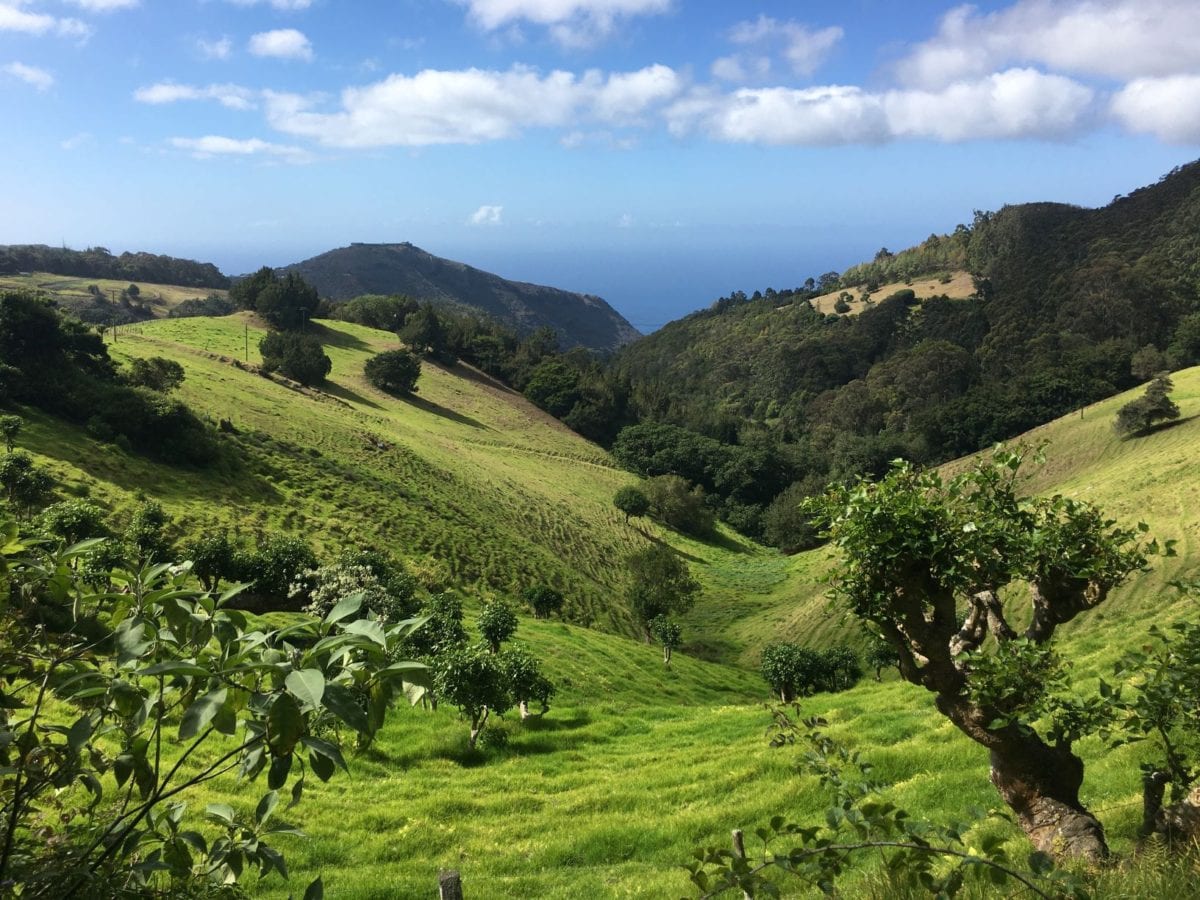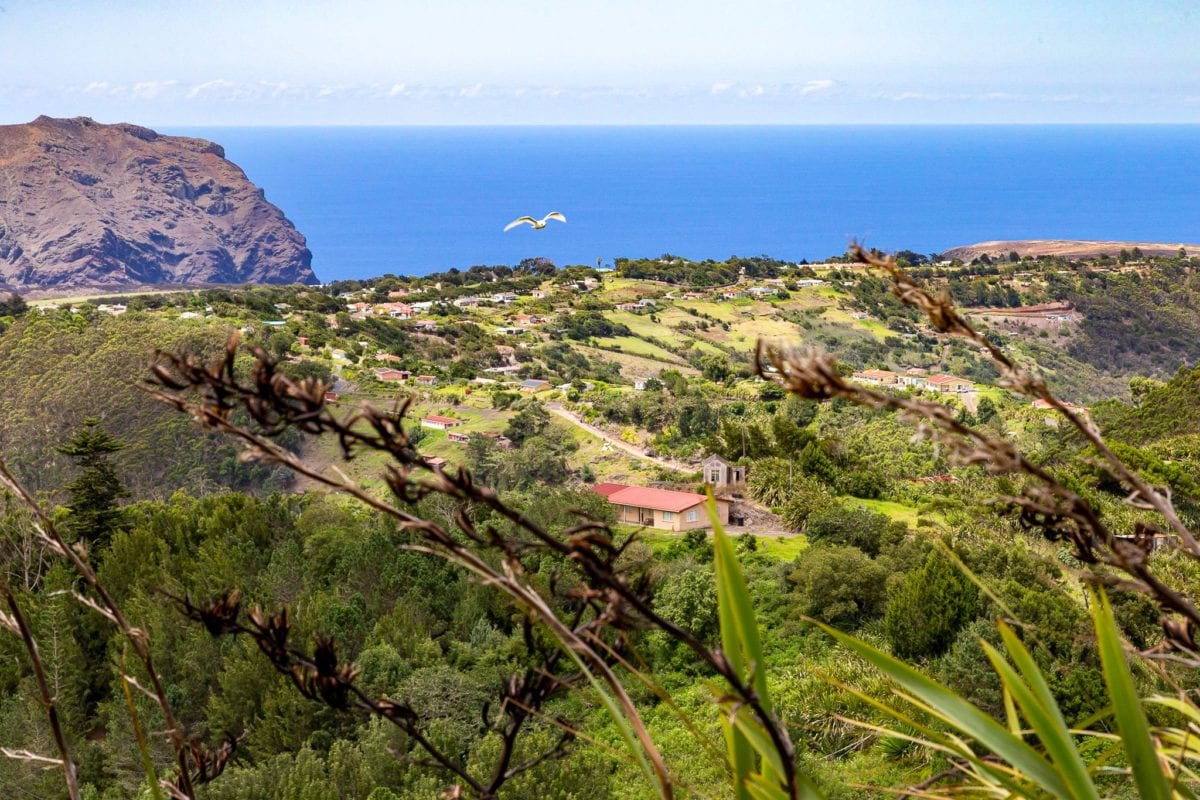On a map, the remote islands of St Helena, Ascension and Tristan da Cunha appear to be mere specks in the ocean – but they have much to enthrall the intrepid traveller.
Tricia Hayne, author of St Helena: the Bradt Guide
Hiking, history and he cabbages: St Helena offers an alluring mix of holiday attractions, but none so great as the sheer grandeur of an island that was wrought from not just one but two huge volcanic eruptions. For dramatic spectacle, it is hard to beat.
Dark cliffs soar straight up from sea level, giving no hint of the landscape imprisoned within: lush valleys, high peaks clothed with extraordinary endemic plants, rolling hills dotted with cows, bleak, barren rock carved over millennia by wind and rain.
St Helena is not just an exceptional backdrop for walking, of course: you can spend hours swimming, diving, fishing or simply taking in the scenery. And don’t forget the wildlife: dolphins are present year round; whale sharks put in an appearance in the summer months, and humpback whales during the winter.
Then there are 500 years of history, from the Napoleonic years to the island’s role in the slave trade and the Boer War. And most important are the St Helenians themselves, a gentle people who genuinely welcome visitors who have made the effort to seek out their remote rock in the middle of the South Atlantic.
To complete your exploration of this outpost of the former British empire, don’t forget that it’s part of a trio that includes Ascension Island, 1,120km further north. And if this isn’t remote enough, Tristan da Cunha could offer just what you need for the ultimate escape.
For more information, check out our guide to St Helena
Food and drink in St Helena
Food
Key to the traditional St Helenian diet – and relatively inexpensive – is fish, and especially tuna, though wahoo and dorado make a regular appearance. Popularly made into fishcakes – which may be served with tomato and onion ‘gravy’ or perhaps pumpkin stew – tuna also surfaces stuffed, grilled and in the other island favourite, pilau. Pronounced ‘ploe’, this local version of the Indian staple combines rice with pretty well any meat or fish and vegetables in a spicy curry sauce.
Indeed, curry is a regular at island dinner tables, but rather more unusually it appears on Sundays and at special occasions such as birthdays and weddings alongside a full English roast with all the trimmings – with both eaten at the same time.
Other island specialities are black pudding, coconut fingers, boiled pudding and bread ‘n’ dance – a simple sandwich with a filling of thickened tomato sauce that is so named because it used to be served at island dances, along with coffee and homemade fruit syrup.
Drink
The local spirit, Tungi, is distilled on the island from the prickly pear, and is very much an acquired taste. The distillery also produces a spiced rum – marketed as White Lion, and sometimes drunk as a shipwreck, with Sprite and a dash of lime – as well as a delicious coffee liqueur, Midnight Mist, based on locally grown coffee. These and other spirits are sold in a particularly attractive bottle, somewhat evocative of Jacob’s Ladder, but they’re cheaper in the standard bottles.
A couple of fairly basic wines, Mount Actaeon and Diana’s Peak, are produced at the distillery, too, but most other drinks – soft and alcoholic – are imported from South Africa. Wines marketed under the Bell Stone brand are simply South African wines that have been labelled in St Helena.
A bottle of red or white wine costs around £5–10 in the shops, or from about £10 in a restaurant, depending on the quality and venue, but don’t expect much in the way of choice. Spirits are relatively expensive.
For a canned soft drink, such as Sprite, you can expect to pay £1 or so in a café, while bottled beer will set you back around £1.40, and a 1.5-litre bottle of water from a shop some £1.05. As in the UK, the minimum age to drink alcohol on licensed premises is 18, but note that in Jamestown, it is against the law to drink alcohol in public.
St Helenian coffee is almost as hard to come by on St Helena as overseas – but it’s good! It’s served – and sold by the bag – at the Coffee Shop in Jamestown, who grow their own, as does the Farm Lodge Country House Hotel.
Known as green-tipped Bourbon Arabica coffee, the local coffee was introduced from the Yemen in 1732, and thrives in the St Helenian environment. If you want to find out more, make time for a visit to the coffee plantation on Rosemary Plain.
Health and safety in St Helena
Health
All visitors to St Helena are required to have valid medical insurance, proof of which must be shown on arrival. This must include coverage for the cost of evacuation in the event of a medical emergency.
Although yellow fever does not occur on St Helena, visitors coming from a yellow fever endemic area must have proof of vaccination against yellow fever. Consult your doctor or a travel clinic at least ten days before your departure.
If the vaccine is not deemed suitable for you then obtain an exemption certificate instead. It is wise to be up to date with tetanus, diphtheria and polio (now given as an all-in-one vaccine, Revaxis, which lasts for ten years). Other vaccines may be recommended, such as hepatitis B for healthcare workers, so if in doubt check with your GP or a travel clinic at least four weeks before you go.
Safety in St Helena
St Helena is generally considered to be pretty safe. Anything more than petty theft, public drunkenness and traffic violations is rare, and the only nuisance that you’re likely to encounter is a noisy stereo or the boom of music from the bars in Jamestown on a Friday and Saturday night.
Only in very rare cases has a violent crime been committed, and even then, the parties concerned have generally had a dispute with each other. On an island where doors are left open, and cars unlocked, it’s easy to get lazy about personal possessions, but it still makes sense to take normal precautions. Keep valuables somewhere sensible (though there’s no such thing as a room safe yet), and don’t flash the cash.
It is generally considered safe to wander around Jamestown after dark, but if you’re walking along country roads at night, watch out for passing cars as the roads are narrow and for the most part unlit.
Recreational drugs of any description are illegal. Although the occasional person has been caught trying to smuggle marijuana on the ship, hard drugs have to date not been a problem. Women travellers can expect to be treated with respect, and are at no greater risk on St Helena than anyone else.
Travel and visas in St Helena
Visas
UK passport holders do not need a visa. If you hold a different passport, check whether you need to apply for a visa here. E-visa applications can be made in advance of arrival on the same website.
Visitors are normally granted a stay of up to 183 days. Those wishing to stay longer may apply for an extension for up to a year from the police station. Given that almost all visitors will be coming to the island via South Africa, do also check whether or not you will need a South African visa, as these cannot be issued on St Helena.
Travel to St Helena
The long-awaited airport finally opened in mid 2016, just four years after work started, meaning that for the first time visitors to the island are greeted not by the cliffs that tower over Jamestown, but by the no-less dramatic volcanic landscape of Prosperous Bay Plain as the plane lands beneath the sheer drop of Great Stone Top as it looms over the sea. It would be hard to imagine a more scenic location for an airport.
At the moment, visitors can fly to the island from the South African cities of Johannesburg and Cape Town. From Johannesburg, Airlink flights leave every Saturday and take just over 6 hours, returning the same day (except for once a month, when the flight continues to Ascension and returns to St Helena and on to Johannesburg on Sunday). Flights from Cape Town run every Tuesday between early December and late February; they also take around 6 hours.
RMS St Helena was ceremonially decommissioned in 2018 after 27 years’ service to St Helena and Ascension. Following this, a new cargo ship, MV Helena, was commissioned to bring supplies to the island. It has been trialling a passenger service since November 2019, with one four-berth en-suite cabin.
The monthly service sails between Cape Town and St Helena, with an overnight stop in Ascension four times a year.
Getting around St Helena
There is a skeletal scheduled bus service and a reasonable number of taxis, but most St Helenians get around by car. For those staying in Jamestown, a combination of walking, taxis and buses can work well, especially if you are into water-based activities, which all start from Jamestown.
For those staying ‘in the country’, or interested in hiking, having your own transport is almost essential. If you don’t have a vehicle and start walking along the road, you may well be offered a lift – but don’t bank on it.
When to visit St Helena
Climate
The climate on Ascension may be sub-tropical, but it is much cooler and drier than that would suggest, with temperatures kept relatively moderate by the persistent southeast trade winds.
At sea level, they average around 79°F (26°C) year-round, peaking in the mid 80s (30s) during the early part of the year, when humidity can be quite high. On Green Mountain, it’s usually about 10–15°F (4–7°C) cooler.
Showers occur throughout the year, with a tendency to being heavier around February and March, but Green Mountain is considerably wetter than the lower-lying areas.
Although St Helena is located in the tropics, her climate is kept generally mild by the southeast trade winds. Despite the vagaries of global warming, summers are generally hot and sunny, and winters cool and mild (though locals would say cold and wet!).
That said, there are noticeable climatic differences between Jamestown, located on the northern coast, and the interior of the island. Jamestown can be sunny and humid, while at the same time Longwood could be experiencing cool mists and a higher amount of rainfall.
Rainfall, while possible at all times, tends to peak in March/April and August, though this, too, varies considerably with elevation. Jamestown averages around 4in (100mm) of rain a year, a figure that rises to 43in (1,083mm) at Scotland, in the district of St Paul’s, at around 2,130ft (650m) above sea level. Similarly, temperatures vary at different points around the island.
In Jamestown, the warmest area on the island, the maximum daytime temperature ranges from 19–37°C (66 to 99°F), while the interior – which is at a higher elevation – is considerably cooler, with the maximum daytime temperature ranging from 18– 24°C (64 to 75°F ). Humidity varies between 70% and 85%.
Events calendar
St Helena is good at festivals. Colourful street parades draw big crowds, whether at Christmas or for one-off carnival occasions. If you’re on the island, keep an eye on the local paper for forthcoming events: perhaps a pancake race on Shrove Tuesday, or simply the Guides and Scouts marching to church on Mothering Sunday.
Its main festival is in November: the Festival of Running. This weeklong occasion, organised by the National Amateur Sports Association (NASAS) and the tourist office, claims to be the most remote running festival in the world. Held annually to raise funds for training local athletes, it incorporates seven events: a 3km fun run/walk, a 10km road race, a 15km trail run, a half and full marathon, a new triathlon, and of course an ascent of the 699-step Jacob’s Ladder.
What to see and do in St Helena
A tour of St Helena’s Napoleonic sites
On 15 October 1815, the British warship Northumberland sailed into James Bay with St Helena’s most famous visitor on board: Napoleon Bonaparte. Exiled following his defeat at the hands of the Duke of Wellington at the Battle of Waterloo, Napoleon and his entourage were weary after weeks cooped up at sea, but their first impressions were not favourable.
As the new arrival scrutinised his ‘island prison’ with the spy glasses he had used on many a battlefield, he is reputed to have said, ‘It is not an attractive place; I should have done better to remain in Egypt’.
On the day of Napoleon’s arrival, a crowd of curious people was waiting at the wharf to greet him, but all in vain. It was decided that he should not come ashore until after sundown the following day, in order to avoid unwanted attention. Even then, it required a troop of soldiers with fixed bayonets to force passage for him to the house of Henry Porteous, on Main Street in Jamestown.
The Porteous house had been chosen as a temporary residence for Napoleon but the French, with an entourage of 26 people, were astounded at its meagreness and felt that the Castle, with its vast rooms, or Plantation House (the governor’s residence) would have been more suitable. After just one night in these cramped quarters, Napoleon, Sir George Cockburn, and Général Bertrand rode about five miles to inspect Longwood House, where work on preparations for Napoleon’s installation was expected to take two months.
Although the house had been used as the summer residence of the lieutenant governor, and Napoleon was assured that it would be transformed into a comfortable residence, he is said to have been disappointed with the dark, low-ceilinged rooms and the bare garden.
It was on the return to Jamestown, when Napoleon decided he could not spend another night at the Porteous house, that he discovered The Briars. So enchanted was he by the estate that he asked about accommodation here while waiting for the renovations to be completed at Longwood House. The Balcombe family, who owned the house, offered Napoleon the use of their home, but he opted instead to occupy the pavilion, situated on top of a hill just 30 yards (27m) from the main house.
Napoleon spent only two months at The Briars, but they proved to be the most enjoyable of his time on St Helena. His relationship with the Balcombe family was friendly, and he became especially fond of their 13-year-old daughter, Betsy. It was with reluctance and sadness that, at the beginning of December, he left to continue his life in exile at Longwood House.
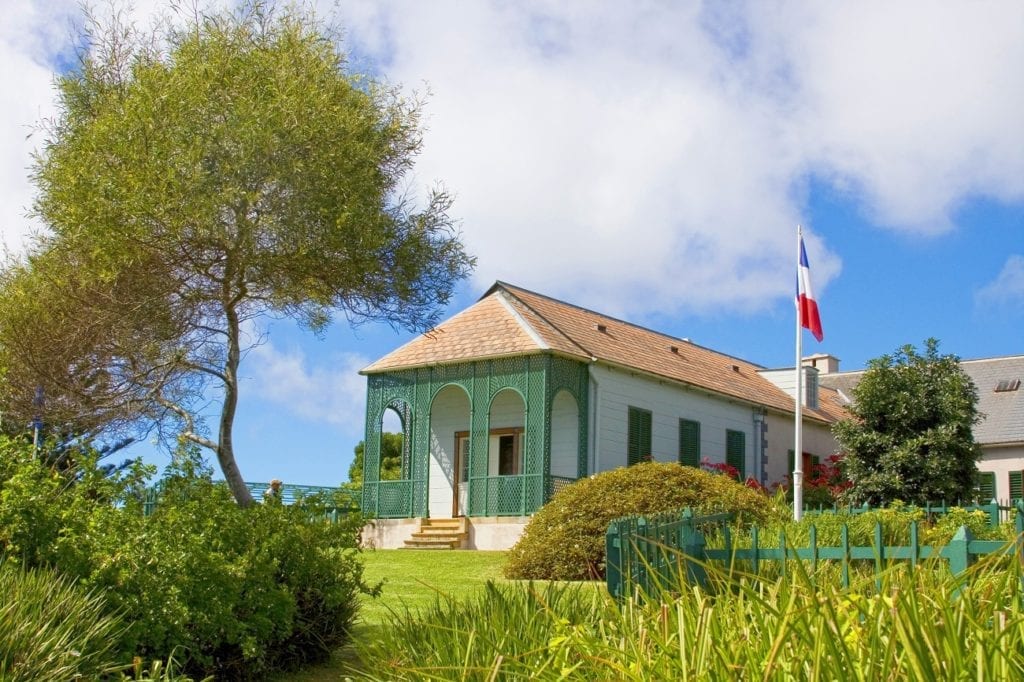
Longwood House
This is well known as the place where Napoleon Bonaparte spent the majority of his exile on St Helena. Perched on an exposed plateau, it can be a depressing place in poor weather, but a visit to Longwood House is a must.
Since 1858, the property – along with the site of Napoleon’s tomb – has been owned by the French government, sold to them for the princely sum of £7,100 by agreement with Queen Victoria. On a sunny day, it is hard to picture the house as it would have been 200 years ago, its walls often dripping with damp, its floors rotten, and fires smoking in every grate.
Many of the pieces of furniture that can be seen at Longwood House date back to Napoleon’s lifetime. These include the billiard table that dominates the entrance, the dining-room table where Napoleon and his entourage endured short but formal dinners every night, and the deep copper bath where he spent an increasing amount of time, as well as the bed in which he died. Most items are labelled, but the audio guide comes with insightful details and commentary, and is therefore well worth the extra cost.
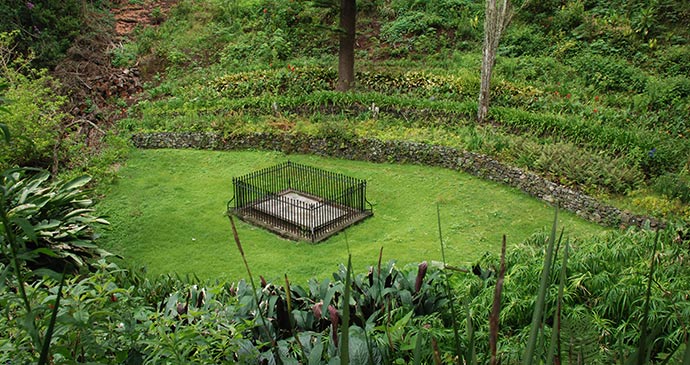
Sane Valley
It is said that Napoleon himself chose Sane Valley as his final resting place – though this was not quite how it turned out. Approached down a sometimes slippery track that was originally cut for the funeral cortege, the original (and now empty) tomb is quite well hidden, about 10–15 minutes’ walk from the road.
Today, a fence separates visitors from the tomb itself, somewhat accentuating its isolation in this lonely but serene spot.
At the time of Napoleon’s interment the tomb was surrounded by willows, but these have now been replaced by Norfolk Island pines, backed by a profusion of well-tended but natural-looking shrubs. Still standing in its original spot, though, is the guard shack: even after Napoleon’s death, the British kept a close watch over the former emperor.
His memorial stone bears no inscription, for the simple ‘Bonaparte’ was rejected by Hudson Lowe, and the French were insulted by his counter-suggestion of ‘Napoleon Bonaparte’. Napoleon’s body, securely encased in four separate coffins, remained here for nearly 20 years until, in 1840, it was removed and taken back to France, where it resides with due decorum at Les Invalides in Paris.
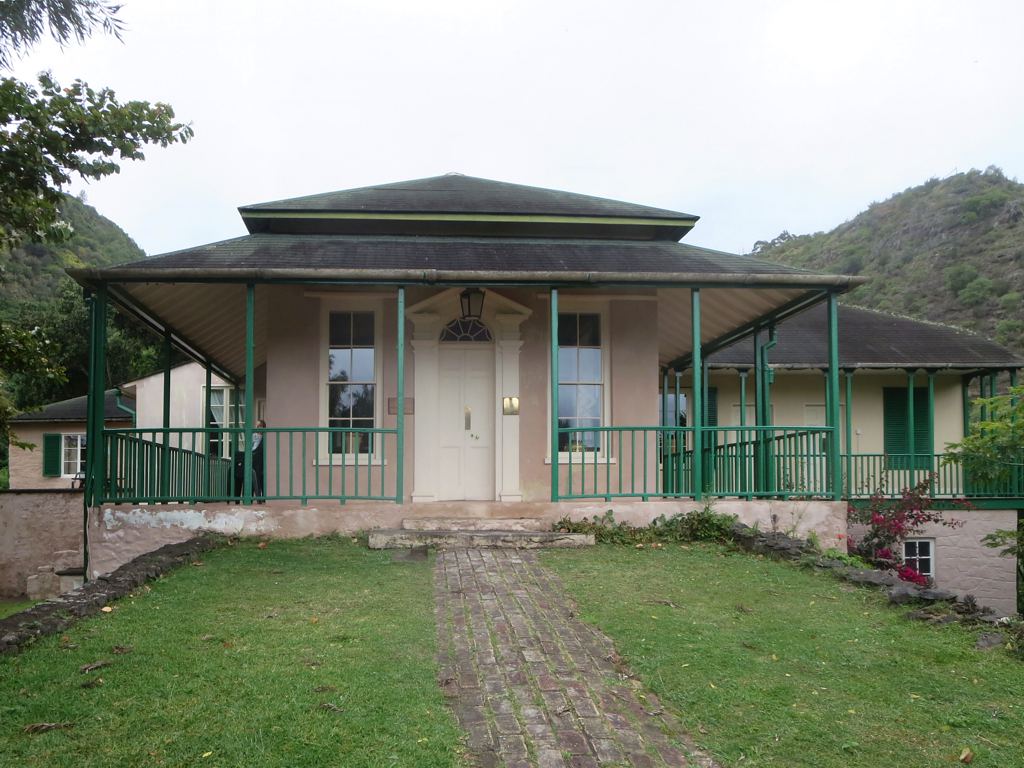
Briars Pavilion
Napoleon spent his happiest time on St Helena at this small pavilion, in the grounds of a house set on a hillside above Jamestown. It was owned by the Balcombe family, and offered down to James Bay.
Their house is long gone, but the pavilion – gifted to the French government in 1959 – is fully restored. Its décor – as at Longwood House – reflects the house at the time of Napoleon’s death. In addition, the attic area, which during Napoleon’s two-month stay was used by Comte de Las Cases and his son, has been sensitively rebuilt from the original plans.
The gardens, too, have been re-established, but what is left of the original furniture from the pavilion is on display at Longwood rather than here.
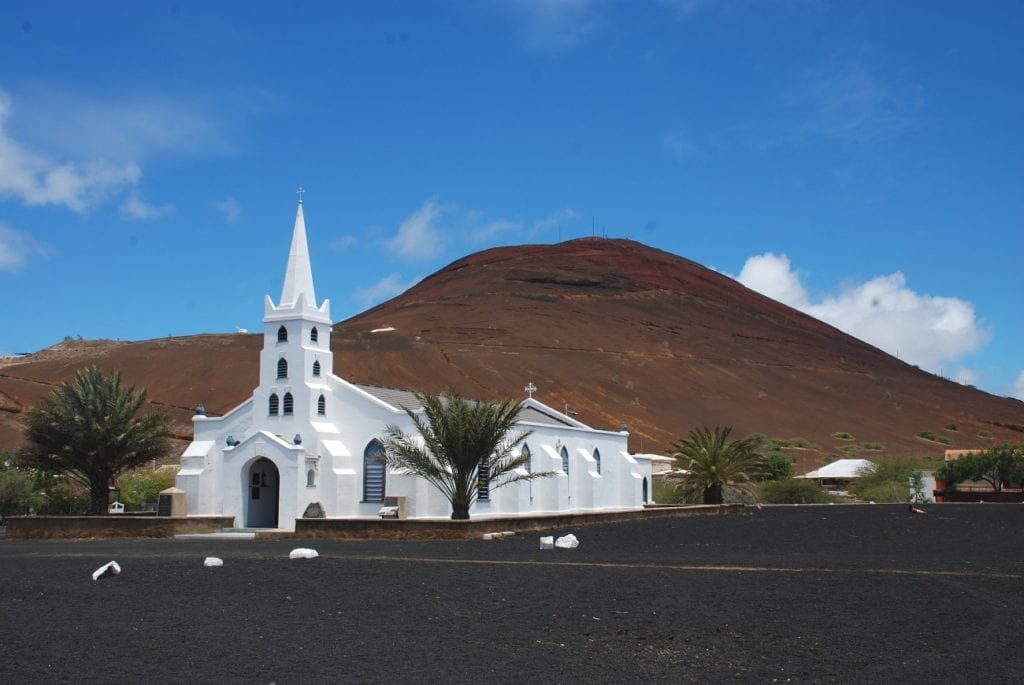
Ascension Island
Ascension Island does not fit into any normal geopolitical pattern. It is essentially a multi-national communications and military hub, but from a political point of view it forms part of the British Overseas Territory of St Helena, Ascension and Tristan da Cunha.
First impressions of Ascension are almost literally out of this world. The largely barren, volcanic, landscape has a special allure all of its own, with rusty red cones, crusty black lava flows, and a slight air of impermanence, more reminiscent of a futuristic new planet settlement than a mid-Atlantic island.
Nevertheless, the island’s more conventional natural beauty will become apparent upon looking away from this Mars-like expanse: the quiet little town of Georgetown; Atlantic rollers crashing on to long, sandy beaches; nesting turtles that lay their eggs by starlight; seabirds in their thousands; and the densely vegetated slopes of a mountain that represent an extraordinary triumph of human intervention over the natural world.
Ascension Island may be a ‘working island’ but it is very much open to visitors. While the tourist infrastructure is modest, and the accommodation on the island is simple, it’s also comfortable, the island uncrowded, and there’s no shortage of activities and places to explore.
You will, though, need to be reasonably self-sufficient. With so few visitors, guided trips in particular can rarely be organised on the spur of the moment, so a little advance planning is well worth the effort.
The best things to see and do on Ascension Island
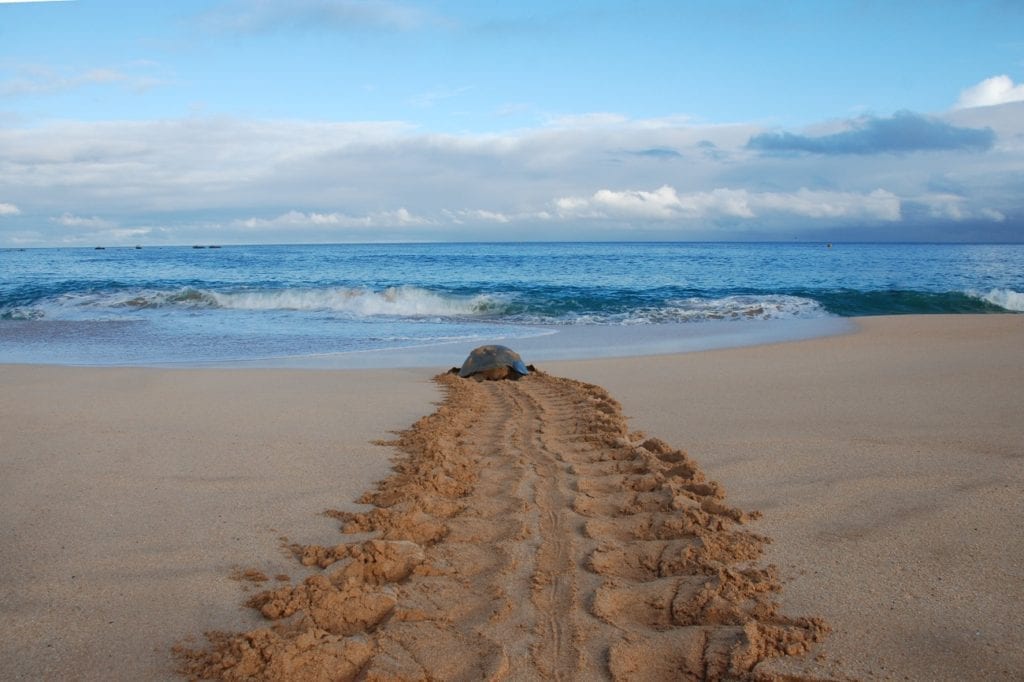
Get up close with the island’s wildlife
Key to many a visit is Ascension’s birdlife (page 133), and specifically the seabird colonies of the Wideawake Fairs and Boatswain Bird Island. Up there with the best sights, too, is the endemic Ascension frigatebird.
More seasonal, but equally unmissable, are the nesting green sea turtles, which are usually here between December and June. To watch one of these lumbering females laying her eggs in the sand is one of the world’s great wildlife experiences. The early part of the year gives the best chance of seeing land crabs when they are spawning, usually around February and March.
Discover the island on foot
Ascension is a great place for hiking, with a varied range of walks that take in volcanic landscapes, lush green cloudforest and challenging coastal paths.
There are numerous walks around the island, including a series of letterbox walks, similar in concept to the postbox walks on St Helena. While the walks are generally better waymarked than those on St Helena, don’t depend on it; it only takes a sign to be obscured by vegetation and you could easily find yourself taking a wrong turning.
The idea of letterboxes derives from a 17th-century practice, when outward-bound ships would leave messages on the island for the next ship to take home. In 1913, the first letterbox, a green tin box, was placed at Letterbox, a peninsula at the easternmost point of the island. Notes were left by visitors at this spot and the next person to come along would take the letter to the post office. The modern set of boxes was set up in 1979, and each now contains a visitors’ book and a handstamp, so that you can authenticate your achievement.
Explore offshore wonders
As on St Helena, the seas around Ascension offer clear, unpolluted waters with some excellent diving and fishing opportunities year-round – provided you arrange things in advance. That said, between June and November gives the greatest chance of calm seas.
The fish life may not be quite as varied here as on St Helena, but it’s certainly big on quantity. Take a look into the waters of any bay and you can’t miss the hundreds of black triggerfish, or grouper, milling around in the shallows. Smartly striped sergeant-major fish vie for attention with squirrelfish, wrasse and resplendent angelfish, while rocky crevices hide moray eels and spiny lobster, and the occasional exquisite fireworm adds a touch of the exotic.
Green Mountain National Park
The only national park on Ascension Island, Green Mountain is a lush forested area quite unlike any other on Ascension. Home to much of the island’s wildlife, including land crabs and six of Ascension’s seven endemic plants, its upper reaches are frequently shrouded in mist. Yet this cloudforest, which supports an extraordinary range of dense vegetation, is effectively manmade, the result of an audacious experiment conducted in the 19th century.
The mountain itself rises to 2,817ft (859m). Along with the introduction of trees and shrubs came the establishment of a farm up here. It was only in the early 21st century that work ceased, the farm fell into disrepair, and the island became almost totally dependent on imported fresh produce. There are now allotments and polytunnels, where a few locals grow their own fruit and vegetables.
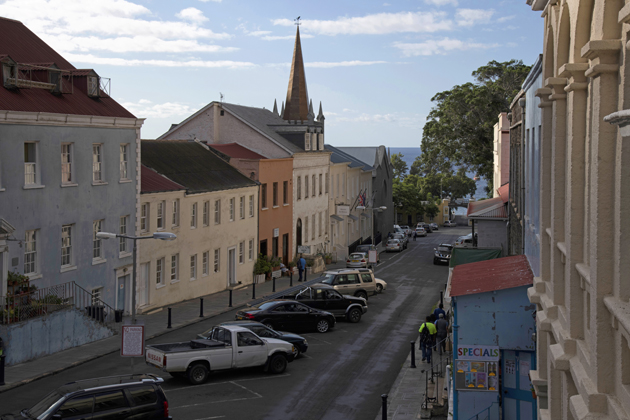
Jamestown
Enclosed on three sides by forbidding walls of rock some 500ft (150m) high, Jamestown is St Helena’s first – indeed only – port of call. For centuries, ships have dropped anchor in its sheltered bay, their passengers ferried ashore on small boats.
But with the airport now operational – and a new wharf being developed in Rupert’s Bay – all this has changed; from now on, most visitors will see the island’s interior before they reach Jamestown.
Founded in 1659, but largely built in the 18th century, Jamestown could almost have been plucked from a Jane Austen novel. The little town stretches up a narrow valley, accessible only along two improbably narrow roads that slope down the hillside from on high.
Its wide central street that once reverberated to the march of soldiers is lined with graceful houses. Its people are used to a slow, measured way of life, where it’s normal to greet a passing stranger. Some visitors spend just a few hours here; others a week or more. However long you have, you’re likely to discover that Jamestown is central to a real understanding of St Helena.
The best things to see and do in Jamestown
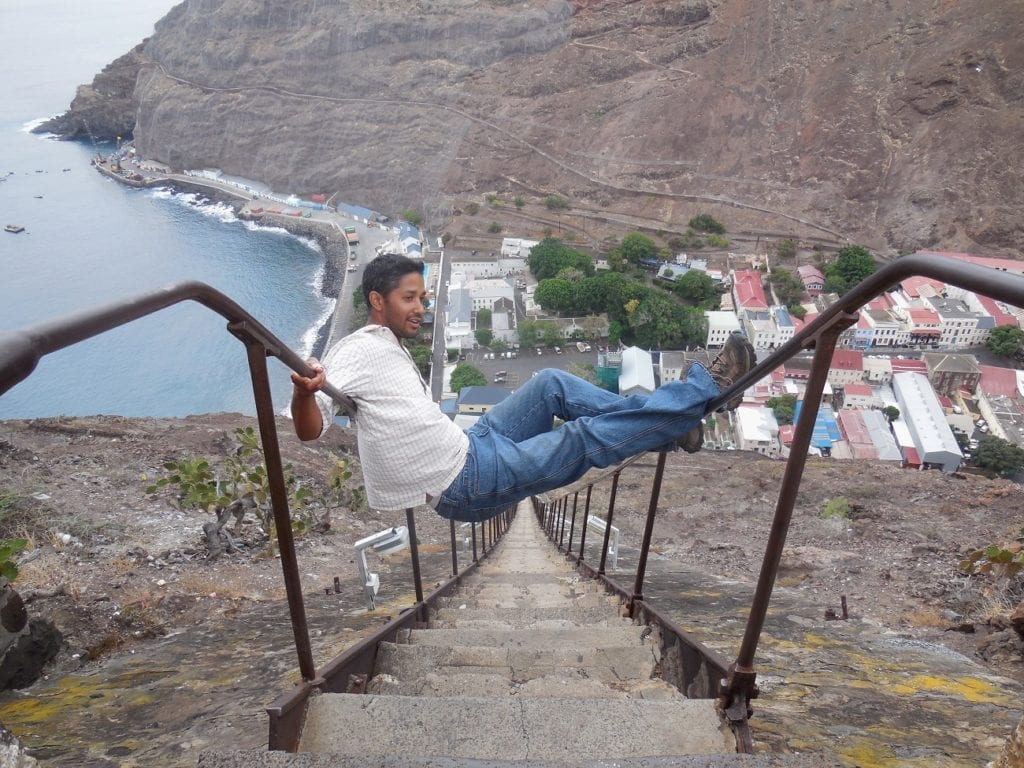
Jacob’s Ladder
Completed in 1829, Jacob’s Ladder was built by the military to transport manure to the countryside from the stables in Jamestown, and to move ammunition and supplies between the capital and the various fortifications around the island.
Once there were tramways at the side of the 699 steps, operated by mules at the top, to haul goods up the 602ft (183m) to Ladder Hill, at an incline of 39–44°. Over the years the ladder has been used by countless schoolchildren, many of whom devised a way of descending that makes sliding down the handrails look very tame by comparison.
Today, it’s still used by a few locals to access Half Tree Hollow from Jamestown, and by others as part of a fitness regime, but for many tourists it’s a challenge in its own right. It’s a tough climb, but the views from the top are worth it, though do note that coming down is equally challenging! And talking of challenges, the record ascent time stands at 5 minutes, 16.78 seconds precisely! Certificates stating that you’ve conquered the ladder are available from the museum for £2.50 each.
St James’s Church
The oldest Anglican church south of the Equator, St James’s stands on or around the site of the first chapel on the island, which was built by the Portuguese at the beginning of the 16th century. Indeed, it is said that the small wooden door behind the rows of pews came from the original chapel, though there is no evidence to prove it.
Taking pride of place in the entrance porch is a large black marble slab, erected ‘by the people of St Helena’ in 2002 to commemorate the year in which full British citizenship was returned to the Saints. Engraved with the salient words from the Royal Charter of 1673, their citizenship rights would appear to be unequivocal, granted by King Charles II as if ‘they had been abideing and borne within this Our kingdome of England’.
The interior of the church feels larger than you might expect in such a small town, and quite stark, until you remember that it served a significant military garrison as well as the civilian population. As if to underline this, several of the pews are marked ‘military’. Above the altar, there is a simple stained-glass window of the Good Shepherd, which was installed in 1874, but aside from the windows to either side of this, adornment is relatively modest.
St Helena Museum
The independent St Helena Heritage Society maintains a fascinating little museum, which was opened in 2002 to coincide with the quincentenary of the discovery of St Helena. Laid out on two levels, it has a lift to the upper storey, and downstairs is a small shop.
First port of call for visitors should be the three-dimensional map of St Helena, a great way to get an understanding of the island’s terrain. Other key exhibits include the original Casson organ from St Paul’s Cathedral (the island’s St Paul’s, not London’s), still in faint working order. Then there are items recovered from the shipwrecked Witte Leeuw and Papanui, those made by Boer War prisoners, former governors’ ceremonial uniforms and other historic costumes, as well as plenty on the island’s military history and maritime tradition. There’s even the huge jawbone of a sperm whale.
Accommodation in Jamestown
Most of St Helena’s accommodation is in Jamestown, with good reason. The small capital is a vibrant microcosm of urban life, with restaurants, cafés and shops, and all water-orientated activities on your doorstep. It’s also the starting point for all guided tours.
On the down side, temperatures in Jamestown can get uncomfortably hot in summer and Lower Jamestown – where most places to stay are located – can occasionally get a little noisy during weekend nights. If that’s likely to be a problem, ask about the location of your room, or consider somewhere out of town.
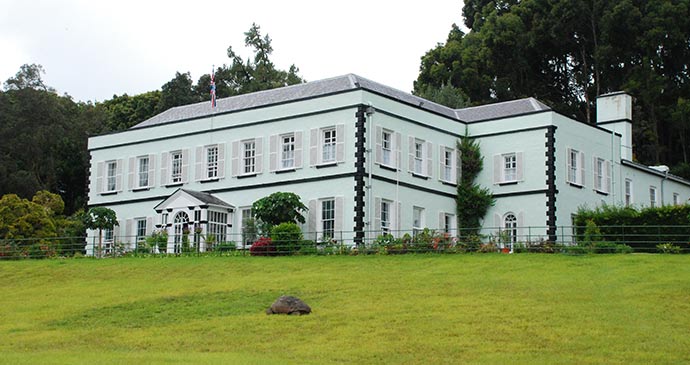
Plantation House
The official residence of St Helena’s governors for more than 200 years, Plantation House is a rather splendid Georgian structure which was built for that purpose between 1791 and 1792. The original was built in 1673, but it fell into disrepair and was replaced in 1722. The second house, initially the home of the plantation manager, in time became the governor’s summer residence.
But this house, too, was plagued with problems, and eventually the East India Company agreed to build a new governor’s residence, which was completed in 1792 for the princely sum of £3,020. During his tenure, between 1816 and 1821, Napoleon’s custodian Governor Hudson Lowe added a library and billiard room, with a nursery above them appropriately known as ‘Chaos’.
Inside, the house is surprisingly light, with an air of tasteful elegance. In the entrance hall are photographs and paintings of the British royal family going back to Prince Albert, and rarely seen photographs of the Duke of Edinburgh sporting a beard. Of the 35 rooms, visitors see just three or four on the ground floor.
Typically these included Hudson Lowe’s comfortable library, restored in 2012 to reflect the original décor; the ‘blue’ lounge; and the particularly impressive dining room, one of the largest rooms in the house. Over the years, many distinguished visitors have been seated around the table, including the Duke of Wellington, Lord Curzon and one of Napoleon’s companions in exile, the Comte de Montholon.
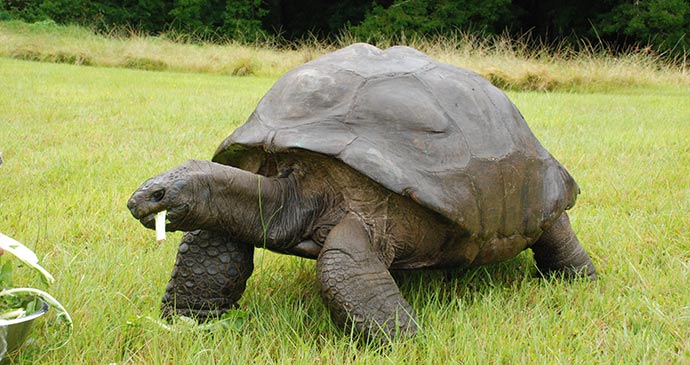
Roaming the large lawn, or paddock, in front of the house are five giant tortoises, which visitors may watch from a fenced-off viewing area without appointment. This is where you’ll find Jonathan, the last surviving Aldabra tortoise, who – at the last estimate in 2015 – was said to be 186 years old.
That said, no-one really knows his age, despite far-fetched claims that he was already here when Napoleon arrived. In reality, it’s likely that he arrived around 1882, possibly brought from the Seychelles when he was fully grown. Whatever the date, age is beginning to take its toll, and today he is hand fed twice a week by the gardeners to ensure that he is properly nourished.
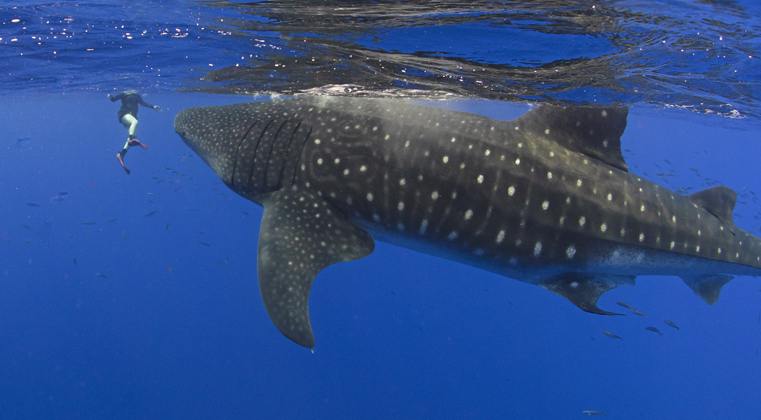
Wildlife watching
One of St Helena’s biggest draws is the appearance of whale sharks around the island. They are usually present between November and May, but visitors in January will have the greatest chance of seeing and perhaps swimming with these truly gentle giants.
The other big marine attraction, humpback whales, arrive during the winter months, between July and December, with calves being present from August. Pods of dolphins, especially the pan-tropical spotted species, are regularly seen off the northwest coast throughout the year.
For birders, the must-see is the wirebird, St Helena’s only surviving endemic bird, which is surprisingly easy to spot year round. Even for the least-interested visitor, the knowledge that you are in the only place in the world where you can see this little plover is pretty humbling.
Botany
St Helena’s unique flora is a botanist’s dream: some 45 endemic plants, many on the brink of extinction. Trees on the peaks flower in succession, so there’s no best time to see them, but if you’d like to spot species like babies’ toes and ice plant in flower, you’ll need to be here around November to January.
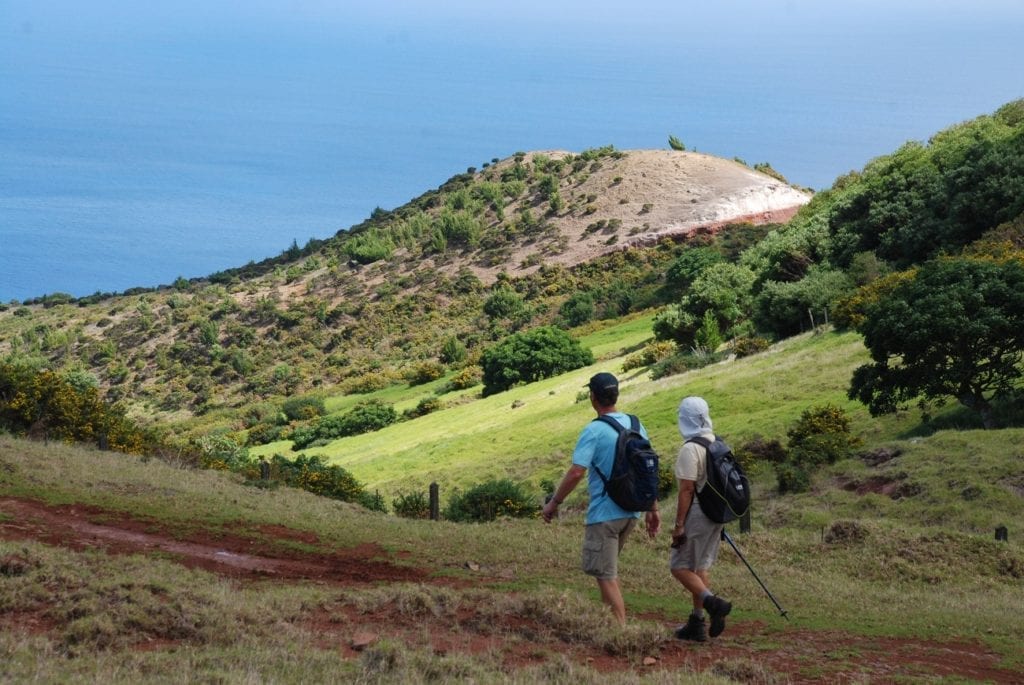
Walking
With its varying and rugged terrain, St Helena is an experienced walker’s paradise. Much of the island is inaccessible by car and the only way to explore the diversity of the landscape is on foot. Its 21 postbox walks and 11 footpaths now have the Green Flag Trail international accreditation status, with an explanatory sign at the start of each walk, as well as a leaflet available at the Tourist Office.
It’s often more pleasant later in the year, although rainfall tends to be higher between July and September.
Diving
Diving in St Helena is extraordinary on many counts – not least the remote location and clear, unpolluted waters. Visibility regularly tops out at around 120ft (40m) between December and May. Not far offshore, the rocks plunge almost straight down into the abyss, so that only 15m or so from the coast you’ll be diving in water that’s up to 3,280ft (1,000m) deep.
In the summer months, between about November and March, water temperatures of around 79°F (26°C) are not unusual, falling to around 66°F (19°C) later in the year, so diving is possible all year round. Typically you’ll be going out in a rigid inflatable boat (RIB), with a back-roll entry, but occasionally one of the operators will take a larger boat instead.
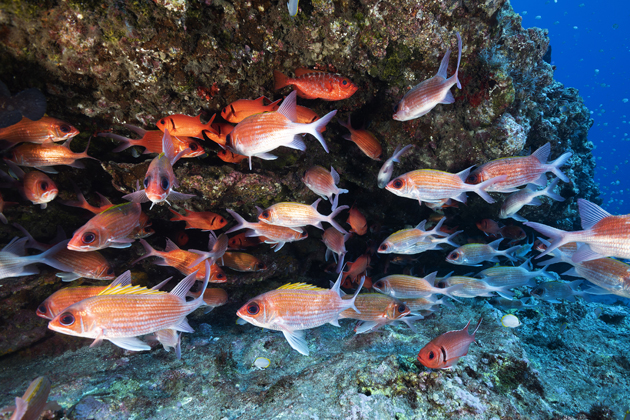
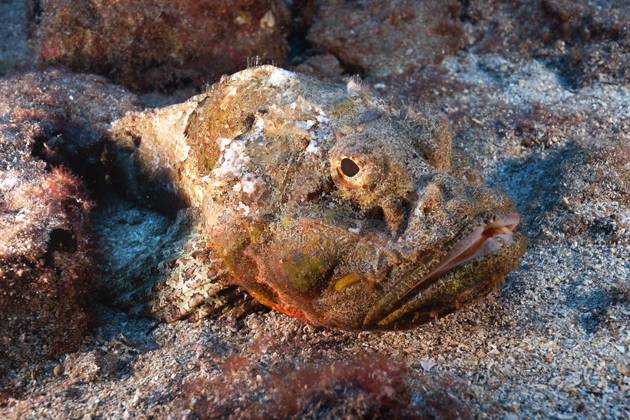
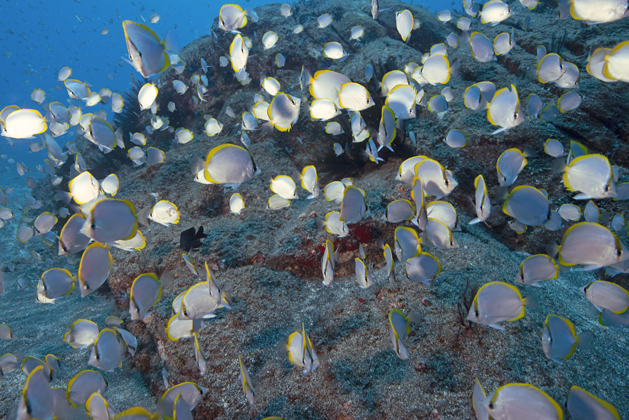
There is no shortage of marine life to be seen in these waters (page 46), including butterflyfish, parrotfish, damselfish, trumpetfish, scorpionfish, jacks, puffers and morays, several of them not seen anywhere else in the world. And the good news is that many of these rarities are very easily enjoyed by snorkellers, as well as divers.
Slip into the water off the wharf in Jamestown, or at Lemon Valley, and you’ll be instantly surrounded by clouds of tiny endemic butterflyfish, their white bodies neatly outlined with bright yellow piping. Look down and you may spot the distinct glimmer of a greenfish, or a lone cowfish, locally known as a hogfish. More widespread is the ghostly trantran, or pipefish, and you can’t miss the ocean surgeonfish – eloquently known as the shitty trooper – which tends to feed in shoals.
Boat trips
As with other water-based activities, boat trips depart from Jamestown, and – with only one or two exceptions – stick to the sheltered northwest of the island. It’s a great way to observe the cliffs from the seaward side, their improbably narrow ledges occupied by pure white fairy terns, and the occasional dangling rope hinting at the lengths a fisherman has gone to secure his catch.
You’ll usually see plenty of dolphin acrobatics, especially in the mornings, and get up close to the bird colonies on Speery and Egg islands. If you’re lucky, you may spot a whale shark at the beginning of the year, while in winter, between around July and September, you may be rewarded by the sighting of a visiting humpback whale.
Fishing
James Bay offers good sportfishing by any standards, especially during the main season, from April to August. Wahoo, yellow-fin tuna and dorado are regularly caught inshore, and larger specimens, as well as marlin and the very occasional sailfish, further out.
Smaller fish such as grouper and bullseye can be caught from the rocks, though do be careful as the seas around here can be pretty volatile and the terrain slippery.
Related books
For more information, see our guide to St Helena:
Related articles
A series of ‘postbox’ walks take travellers on a round-the-island walking tour, showcasing the very best of St Helena’s scenic beauty.
Savour the tastes of St Helena with this recipe for the South Atlantic island’s classic comfort food.
Photographer Mathias Falcone shares his favourite shots from one of the world’s most remote islands.
